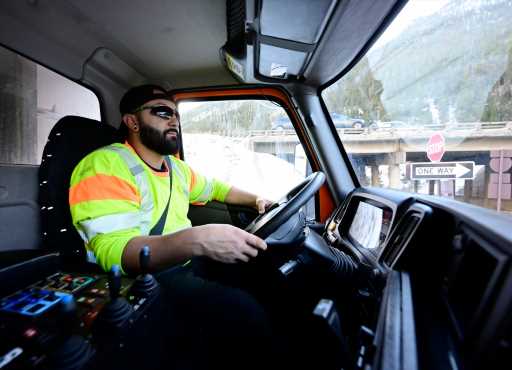A new tool lets users track Colorado Department of Transportation snowplows and the crews that use them to clear roads for safe travels during winter storms.
The online COtrip map, which already gave users highway information from around the state, including camera images, construction information, electronic signs, road conditions and road closures, is now tracking CDOT snowplows in real-time.
It’s the first season that the public is able to track snowplow locations and work areas on the map, and it includes the plows’ names, such as Darth Blader, Snowtorious B.I.G., and Eisenplower, which were submitted and voted on by Colorado kids from across the state in 2021.
One thing the map doesn’t include is which crewmate is behind the wheel of a particular plow. Joe Duarte, who has been with CDOT for three years, works with fellow crew members on the Interstate 70 mountain corridor from Idaho Springs to the Eisenhower Tunnel, as well as Berthoud and Loveland passes.
Duarte, on a recent sun-splashed day with no snow falling, drove the I-70 approach toward the east side of the Eisenhower Tunnel in Darth Blader.
“It is kind of cool that it was named by the public,” Duarte said of Darth Blader, before admitting to being more partial to another truck name. “Eisenplower! I like that one.”
When plows head out onto snowy roads, drivers in Duarte’s mountain area typically work in crews of two or three, he said. When it’s snowing, their shifts last 12 hours.
“When we’re out, it’s for a specific purpose — to make sure the public safely gets where they want to go,” Duarte said.
The typically busy eastside approach to the Eisenhower Tunnel is a challenge: The stretch of highway has a gradual, steep incline and there are limited turnaround points for the plow trucks, which are more than 40 feet long and 16 feet wide.
“I-70 storms can come in very quick with several inches of snow per hour,” Duarte said. .
The plow trucks, made by International with Cummings diesel engines, cost about $350,000 when newly purchased. CDOT officials plan to get at least 12 years of service out of each truck, sometimes stretching the years of service to 18. Most trucks retired by CDOT are sold at auction.
Statewide, CDOT has 876 snowplow trucks and the annual winter operations budget is about $100 million.
When plow drivers head out from the yard at the start of a shift in snowfall, they’ll typically drive about 300 miles, traveling at an average of about 35 mph and getting about 3.5 mpg, before wrapping up.
In the Darth Blader cab the console is filled with more than a dozen equipment control buttons and there are three joysticks to the right of the driver, including one to operate the plow’s front blade. A touch-screen video monitor is used to program the amount of deicing agents that the truck applies to the roadway on the fly. Drivers monitor a scanner for highway information and instructions while communicating with fellow crew members.
“It can be overwhelming at times,” Duarte said of the job. “It’s something you get used to and it becomes second nature.”
CDOT plow drivers, at a minimum, have a Commercial Drivers License (class B) and some drivers have special endorsements, including clearance to haul hazardous materials. For example, Duarte is a member of CDOT’s avalanche crew, so he is trained to haul and use explosives.
During the offseason — summer months — plow drivers keep busy working on the highway system, including mending guard rails, repairing road surfaces, and applying trade skills like welding. During dry stretches in the winter, drivers work on vehicle maintenance and other tasks around the maintenance facility.
“I love it,” Duarte said. “There is a very wide range of different acts we are responsible for.”
Source: Read Full Article


